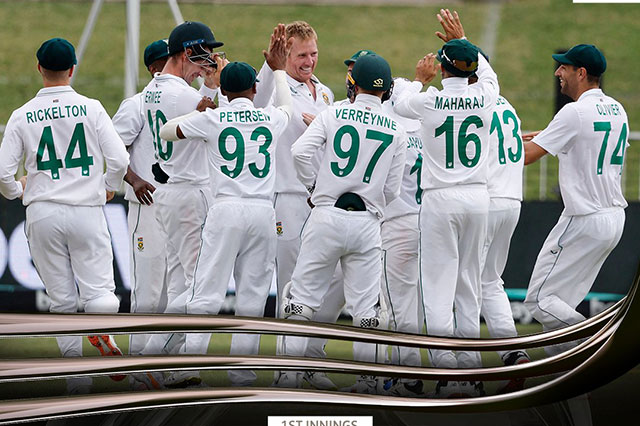The India series revealed how close the Proteas are to mounting a significant T20 World Cup challenge, but also highlighted just how far they are in meaningful ways. RYAN VREDE examines three key areas of concern.
Five games are scheduled (three vs England, two vs Ireland) before the start of the T20 World Cup in October, although this week, Proteas head coach Mark Boucher indicated that there are five more warm-up matches in the pipeline.
The Proteas were impressive in the first two matches of the India series, but faded badly thereafter. They limped into the decider, and it felt like a merciful intervention from the cricket gods when that fixture was rained out.
They have work to do in key facets of their team and tactical construction, as well as some hard personnel questions to answer. These are three of those.
Who opens the batting with Quinton de Kock?
This is arguably the most serious deficiency in the team at present. Both Temba Bavuma and Reeza Hendricks are completely out of form. And with just five matches to the format’s showpiece event, time is running out to solve this problem.
Faf du Plessis is a readymade solution, but the selectors appear to have moved on from him. I suspect there’s a similar reluctance to pick Rilee Rossouw, who has been excellent in the T20 Blast.
The logical next in line would then be Pieter Malan, who excelled in the CSA T20 Challenge. Wihan Lubbe, who also impressed in the competition, is another whose performances have him in the conversation.
Elevating Aiden Markram is an alternative. In this scenario, Rassie van der Dussen would bat at No 3 and Bavuma at four. But the selectors would be reluctant, given Markram’s excellence at No 4, where he averages nearly 40, compared with an average of 32 while opening the batting.
There’s also the possibility that they persist with using Dwaine Pretorius at No 3, which would force David Miller further down the order. This is not ideal.
So, there are options available to the selectors. But time is against them. They need to either invest in Bavuma’s intensive rehabilitation, or pick De Kock’s new partner for the England tour and stick with him.
Who bowls the death overs?
Kagiso Rabada will operate in this period of the match. Then the Proteas will look to a combination of Anrich Nortje, Dwaine Pretorius and either Wayne Parnell or Marco Jansen to finish the job.
When the Proteas have bowled well in the powerplay, the pressure on the death bowlers has eased significantly. This is the ideal scenario. However, this is not certain, so the skills, composure and intelligence needed to operate at the death must be improved in the upcoming series.
The Rabada-Nortje-Pretorius combination is the most likely to front their World Cup challenge. There is more hope than certainty about that trio, and the series in England will tell us all we need to know about their competency in this area.
Do they play two spinners?
I don’t have insight into Boucher’s thinking on this matter, but he has backed two spinners in recent history and is likely to continue to do so at the World Cup.
So much hangs on Keshav Maharaj bowling well, whether he is deployed at the start of the innings, or in the middle overs. If he can “hold” effectively, Tabraiz Shamsi becomes a potent weapon. In the absence of this, the Proteas tend to leak runs in this partnership.
There are combinations they can play with if they abandon the two specialist-spinners approach. Aiden Markram has done a solid job with the ball. Him getting through four overs is a gamble, though, particularly on Aussie tracks. This would allow them to pick another specialist batter or an all-rounder, giving them depth in that department. In the latter scenario, Parnell and Marco Jansen would compete for a spot.
If the selectors opt for one of the two spinners, it would most likely be Maharaj, who has shown himself to be more consistent in stopping the flow of runs, albeit not as threatening a wicket-taker as Shamsi.
That wicket threat will come from Rabada, and a fully fit Nortje, while Pretorius is adept at taking sticks deeper in the innings. Parnell or Jansen, whose left-arm pace offers the attack necessary variation, and who are both competent batters, could complete an attack that features just one spinner.
If the selectors’ decision is going to be led by data, the Big Bash League is a good place to start. Four of the tournament’s 10 leading wicket-takers were spinners.
However, the stats become more revealing when you consider that spinners dominated the tournament’s rankings for the best economy rates (of the bowlers who bowled 20 or more overs), with the likes of Mujeeb Ur Rahman (6.26), Mitchell Swepson (6.75), Rashid Khan (6.87), Zahir Khan (6.93), Stephen O’Keefe (6.93) Imad Wasim (7.15), Benjamin Manenti (7.22) and Adam Zampa (7.35) all excelling at chocking the run-rate.
It is self-evident that good spinners are assets in Australia in T20 cricket. And in Maharaj and Shamsi, the Proteas have two of the game’s best.
Follow African Insider on Facebook, Twitter and Instagram
Source: SA Cricket
Picture: Twitter/@ICC
For more African news, visit Africaninsider.com


